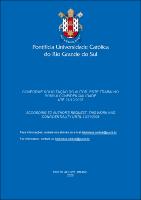| Share record |


|
Please use this identifier to cite or link to this item:
https://tede2.pucrs.br/tede2/handle/tede/9457| Document type: | Dissertação |
| Title: | Produção e caracterização de polímero magnético e isolante elétrico via processo físico de deposição |
| Author: | Vilar, Samuel Corvello  |
| Advisor: | Feil, Adriano Friedrich |
| Abstract (native): | As nanopartículas (NPs) apresentam propriedades químicas e físicas diferenciadas dos seus pares no estado bulk devido aos efeitos de superfície e de forma que surgem devido ao efeito de confinamento quântico. Dois fenômenos físicos de nanopartículas magnéticas são importantes do ponto vista tecnológico: O estado superparamagnético e a formação de monodomínios, que surgem quando partículas têm suas dimensões reduzidas à escala nanométrica (<100 nm). Essa particularidade das NPs magnéticas pode ser combinada com uma matriz polimérica, resultando em um material que seja isolante elétrico e que tenha propriedades magnéticas. No presente trabalho é utilizado um método sintético baseado no processo de deposição física de partículas metálicas sobre o pó de polietileno de alta densidade, via magnetron sputtering, com variação no tempo de deposição de partículas da liga ferro-níquel, chamada de permalloy, resultando em diferentes concentrações metálicas no substrato polimérico. A técnica de medida de Magnetização DC foi utilizada para caracterização magnética do material sintetizado e as propriedades elétricas foram caracterizadas por Espectroscopia de Impedância, que utiliza sinal alternado de tensão e corrente elétrica em diferentes frequências, e por Voltametria de varredura linear, que utiliza sinal contínuo de tensão e corrente elétrica. As medidas de concentração estimada de metal no polímero foram obtidas pelas técnicas EDS (Energy dispersive x-ray spectroscopy) e RBS (Rutherford Backscattering Spectroscopy). Para caracterização morfológica do material obtido foi utilizada a Microscopia Eletrônica de Varredura (MEV). A partir das medidas magnéticas, o diâmetro dos aglomerados de partículas foi obtido por simulação baseada na Função de Langevin, indicando a existência de nanopartículas no estado superparamagnético, organizadas em monodomínios magnéticos. Esse material é potencialmente atrativo do ponto de vista tecnológico para aplicações em transformadores, substituindo os tradicionais núcleos ferrosos, tendo a vantagem de ser um material mais leve, com propriedades dielétricas, com ausência significativa de histerese magnética e livre de correntes de Foucault. |
| Abstract (english): | Nanoparticles (NPs) exhibit different chemical and physical properties from their bulk counterparts due to surface effects and shape that arise due to the quantum confinement effect. Two physical phenomena of magnetic nanoparticles are technologically important: The superparamagnetic state and the formation of monodomains, which arise when particles have their size reduced to the nanometer scale (<100 nm). This particularity of magnetic NPs can be combined with a polymer matrix, resulting in a material that is electrical insulating and has magnetic properties. In the present work a synthetic method based on the physical deposition process of metallic particles on the high-density polyethylene powder via magnetron sputtering is used, with variation in the deposition time of ferro-nickel alloy particles, called permalloy, resulting in different metallic concentrations in the polymeric substrate. The DC magnetization measurement technique was used for magnetic characterization of the synthesized material and the electrical properties were characterized by impedance spectroscopy, which uses alternating voltage and current signal at different frequencies, and linear scanning voltammetry, which uses continuous signal of voltage and current. Measurements of estimated metal concentration in the polymer were obtained by the EDS (Energy dispersive x-ray spectroscopy) and RBS (Rutherford Backscattering Spectroscopy) techniques. For morphological characterization of the material obtained, Scanning Electron Microscopy (SEM) was used. From the magnetic measurements, the diameter of the particle agglomerates was obtained by Langevin Function simulation, indicating the existence of superparamagnetic nanoparticles, organized in magnetic monodomains. This material is potentially attractive from a technological point of view for applications in transformers, replacing the traditional ferrous cores, having the advantage of being a lighter material, with dielectric properties, with a significant absence of magnetic hysteresis and free of eddy currents. |
| Keywords: | Polímero magnético Nanopartículas Magnetron sputtering Magnetic polymer Nanoparticles Magnetron sputtering |
| CNPQ Knowledge Areas: | ENGENHARIAS |
| Language: | por |
| Country: | Brasil |
| Publisher: | Pontifícia Universidade Católica do Rio Grande do Sul |
| Institution Acronym: | PUCRS |
| Department: | Escola Politécnica |
| Program: | Programa de Pós-Graduação em Engenharia e Tecnologia de Materiais |
| Access type: | Acesso Aberto |
| Fulltext access restriction: | Trabalho será publicado como artigo ou livro |
| Time to release fulltext: | 60 meses |
| Date to release fulltext: | 21/12/2025 |
| URI: | http://tede2.pucrs.br/tede2/handle/tede/9457 |
| Issue Date: | 26-Aug-2019 |
| Appears in Collections: | Programa de Pós-Graduação em Engenharia e Tecnologia de Materiais |
Files in This Item:
| File | Description | Size | Format | |
|---|---|---|---|---|
| DIS_SAMUEL_CORVELLO_VILAR_CONFIDENCIAL.pdf | SAMUEL_CORVELLO_VILAR_DIS | 502.23 kB | Adobe PDF |  Download/Open Preview |
Items in DSpace are protected by copyright, with all rights reserved, unless otherwise indicated.




